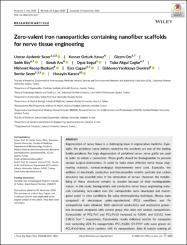| dc.contributor.author | Aydemir Sezer, Ümran | |
| dc.contributor.author | Öztürk Yavuz, Kevser | |
| dc.contributor.author | Örs, Gizem | |
| dc.contributor.author | Bay, Sadık | |
| dc.contributor.author | Aru, Başak | |
| dc.contributor.author | Söğüt, Oğuz | |
| dc.contributor.author | Akgül Çağlar, Tuba | |
| dc.contributor.author | Bozkurt, Mehmet Recep | |
| dc.contributor.author | Çağavi, Esra | |
| dc.contributor.author | Yanıkkaya Demirel, Gülderen | |
| dc.contributor.author | Sezer, Serdar | |
| dc.contributor.author | Karaca, Hüseyin | |
| dc.date.accessioned | 2021-01-11T08:32:51Z | |
| dc.date.available | 2021-01-11T08:32:51Z | |
| dc.date.issued | 2020 | en_US |
| dc.identifier.citation | Aydemir Sezer, Ü., Öztürk Yavuz, K., Örs, G., Bay, S., Aru, B., Söğüt, O. ... Karaca, H. (2020). Zero-valent iron nanoparticles containing nanofiber scaffolds for nerve tissue engineering. Journal of Tissue Engineering and Regenerative Medicine, 14(12), 1815-1826. https://dx.doi.org/10.1002/term.3137 | en_US |
| dc.identifier.issn | 1932-6254 | |
| dc.identifier.issn | 1932-7005 | |
| dc.identifier.uri | https://dx.doi.org/10.1002/term.3137 | |
| dc.identifier.uri | https://hdl.handle.net/20.500.12511/6216 | |
| dc.description.abstract | Regeneration of nerve tissue is a challenging issue in regenerative medicine. Especially, the peripheral nerve defects related to the accidents are one of the leading health problems. For large degeneration of peripheral nerve, nerve grafts are used in order to obtain a connection. These grafts should be biodegradable to prevent second surgical intervention. In order to make more effective nerve tissue engineering materials, nanotechnological improvements were used. Especially, the addition of electrically conductive and biocompatible metallic particles and carbon structures has essential roles in the stimulation of nerves. However, the metabolizing of these structures remains to wonder because of their nondegradable nature. In this study, biodegradable and conductive nerve tissue engineering materials containing zero-valent iron (Fe) nanoparticles were developed and investigated under in vitro conditions. By using electrospinning technique, fibrous mats composed of electrospun poly(epsilon-caprolactone) (PCL) nanofibers and Fe nanoparticles were obtained. Both electrical conductivity and mechanical properties increased compared with control group that does not contain nanoparticles. Conductivity of PCL/Fe5 and PCL/Fe10 increased to 0.0041 and 0.0152 from 0.0013 Scm(-1), respectively. Cytotoxicity results indicated toxicity for composite mat containing 20% Fe nanoparticles (PCL/Fe20). SH-SY5Y cells were grown on PCL/Fe10 best, which contains 10% Fe nanoparticles. Beta III tubulin staining of dorsal root ganglion neurons seeded on mats revealed higher cell number on PCL/Fe10. This study demonstrated the impact of zero-valent Fe nanoparticles on nerve regeneration. The results showed the efficacy of the conductive nanoparticles, and the amount in the composition has essential roles in the promotion of the neurites. | en_US |
| dc.language.iso | eng | en_US |
| dc.publisher | Wiley | en_US |
| dc.rights | info:eu-repo/semantics/embargoedAccess | en_US |
| dc.subject | Electrospin | en_US |
| dc.subject | Iron Nanoparticles | en_US |
| dc.subject | Nerve Regeneration | en_US |
| dc.subject | Polycaprolactone | en_US |
| dc.subject | Tissue Engineering | en_US |
| dc.subject | Zero Valent | en_US |
| dc.title | Zero-valent iron nanoparticles containing nanofiber scaffolds for nerve tissue engineering | en_US |
| dc.type | article | en_US |
| dc.relation.ispartof | Journal of Tissue Engineering and Regenerative Medicine | en_US |
| dc.department | İstanbul Medipol Üniversitesi, Rektörlük, Rejeneratif ve Restoratif Tıp Araştırmaları Merkezi (REMER) | en_US |
| dc.department | İstanbul Medipol Üniversitesi, Rektörlük, Sağlık Bilim ve Teknolojileri Araştırma Enstitüsü | en_US |
| dc.department | İstanbul Medipol Üniversitesi, Sağlık Bilimleri Enstitüsü, Sinirbilim Ana Bilim Dalı | en_US |
| dc.department | İstanbul Medipol Üniversitesi, Tıp Fakültesi, Temel Tıp Bilimleri Bölümü, Tıbbi Biyoloji Ana Bilim Dalı | en_US |
| dc.authorid | 0000-0001-8089-1330 | en_US |
| dc.authorid | 0000-0002-7199-583X | en_US |
| dc.identifier.volume | 14 | en_US |
| dc.identifier.issue | 12 | en_US |
| dc.identifier.startpage | 1815 | en_US |
| dc.identifier.endpage | 1826 | en_US |
| dc.relation.ec | info:eu-repo/grantAgreement/TUBITAK/SOBAG/214S672 | |
| dc.relation.publicationcategory | Makale - Uluslararası Hakemli Dergi - Kurum Öğretim Elemanı | en_US |
| dc.identifier.doi | 10.1002/term.3137 | en_US |
| dc.identifier.wosquality | Q2 | en_US |
| dc.identifier.scopusquality | Q2 | en_US |


















